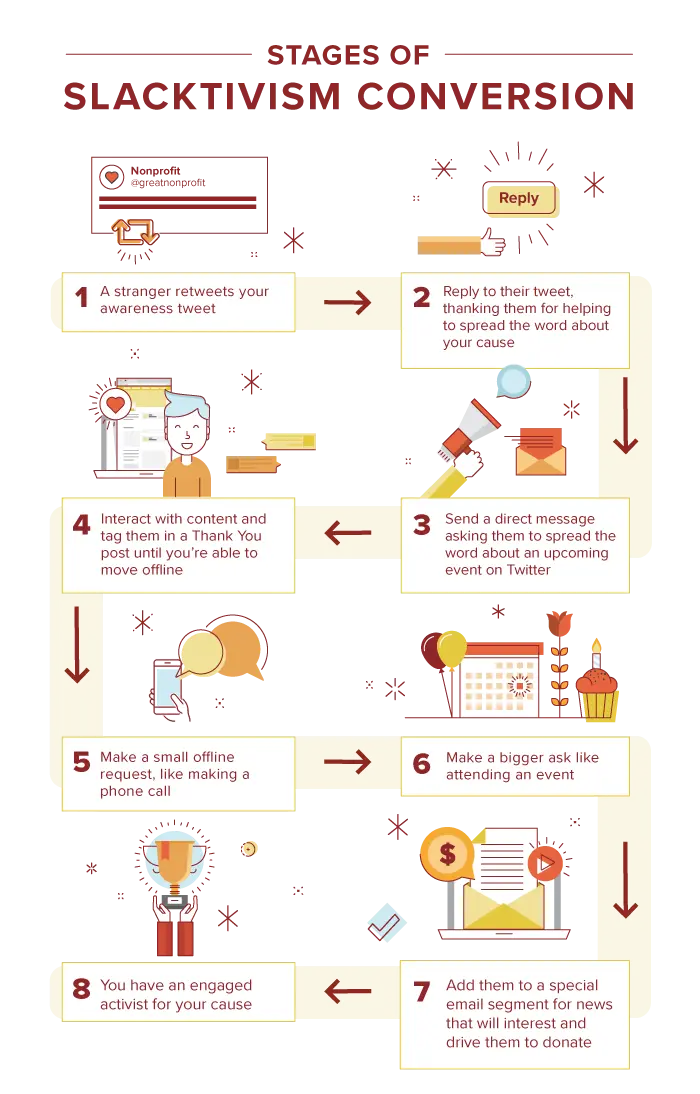In the age of social media, we’re seeing time and time again that anything can be a fad. Fanny packs, popped collars, the phrase “awesome sauce” and even *gasp* activism. Slacktivism, as many refer to it, occurs when causes come into the spotlight through viral social media attention without many tangible new supporters to show for it.
When I talk about slacktivism, I’m talking about a person who engages with an organization or cause over social media and takes no further action. This is the person who shared a (tear-jerking) post requesting donations to save a rescue dog’s life and get it the medical care it needs, but who did not actually make a donation, volunteer time or support the shelter in any physical way.
Looking through your nonprofit’s Facebook and Twitter followers, likers and commenters, do you recognize all of the names and faces? I’m betting you have more than a few slacktivists on your list.
Slacktivists are More Likely to Engage
Slacktivists are willing to share your cause or nonprofit specifically on social media, but they often fall through the cracks of relationship building and further engagement. This makes them different from the average stranger you’re hoping to draw into your cause through awareness efforts. Since you’ve interacted on social media, they already know who you are, and they already care about your cause to some extent. Both of these points make them more likely to engage with you further if given the right opportunity.
If they’re posting about your cause, you likely share a similar value that you can then build off of. For example, once they post about your cause, they’re more likely to post again if you give them something to say. And in that line of thinking, once they post about a fundraiser or event, they are more likely to attend and complete other important actions once their awareness efforts are encouraged.
If you have a social media ambassador program at your nonprofit, former slacktivists are excellent candidates. They’re already posting about your nonprofit to their followers!
Stages of the Slacktivism Conversion
The following infographic walks you through a prototypical path you can follow as you build relationships with slacktivists in your network, starting with a retweet and ending in a newborn activist for your cause. We’re using Twitter here, but the process can be replicated on any social media platform.

Social Media Message Template
When you find a slacktivist, reach out to them and thank them for their support. If you can, make it personal and make them feel good about what they did for your cause, however small.
Thanks for helping to spread awareness about [insert cause]! We’re working to [insert mission] and your support means a lot.
When you’re ready to reach out to this person again, send them a direct message with a small ask that’s relatively similar to their initial action.
Hello again! We’re gearing up for [insert campaign/event/etc] and were hoping you could help us spread the word. Would you mind sharing this post with your followers?
[insert post content you’d like to share]
Once they complete this task, you can carry them through the stages of slacktivism conversion. All asks should be clear and easy to follow. As with any ask, the easier you make it for people, the more likely they are to actually do it.
Not every slacktivist you reach out to will become a full-fledged activist. But don’t forget that even if all they contribute is one post, that post may have been seen by viewers who would not otherwise know about your cause. Extra awareness is never a bad outcome, even if it doesn’t lead to any further action.
Do you have slacktivists hanging out in your social media following? What have you done to transform them into activists? Share your stories in the comments!

Comments